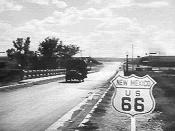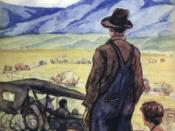When John Steinbeck's novel The Grapes of Wrath was published in 1939, it caused an uproar in this nation. The inside cover of the novel states, "It electrified an America still convalescing ideas that many people were, at the least, uncomfortable with this electlicity caused the Kern County Board of Supervisors to ban the book in the county's public schools and libraries on August 22, 1939.
The Grapes of Wrath was mostly set in Kern County, California and illustrated the "corporate landowners"' cruelty towards the "exploited agricultural workers. These agricultural workers were usually derogatorily called "Okies," because most of them had migrated from Oklahoma. Others came from Arkansas, Kansas, and New Mexico. After the years of drought in the area that became known as the Dust Bowl and after they were thrown off their land, these farmers moved to California to start a new life, hoping to own their land.
However, their luck was not as large as their hope and many were left homeless and unemployed.
According to Steinbeck's novel, this was because the California landowners barely paid the workers enough to live on. Apparently, this offended some of Kern County's citizens, especially the Associated Farmers of Kern County. They completely supported the Board of Supervisors' resolution that stated the novel "misrepresented conditions in the county and the whole San Joaquin Valley and blamed the local farmers for the plight of the indigent farmers. The group also solicited other organizations in the valley for support. W.B. Camp, a prominent rancher of the time and president of the Associated Farmers, said that his organization would "fight to remove the 'smear' on the good name of Kern, the state of California and agriculture.
Despite the denials of those who felt they were falsely portrayed by Steinbeck, there are those who were...


